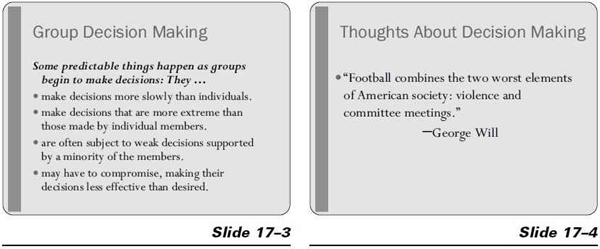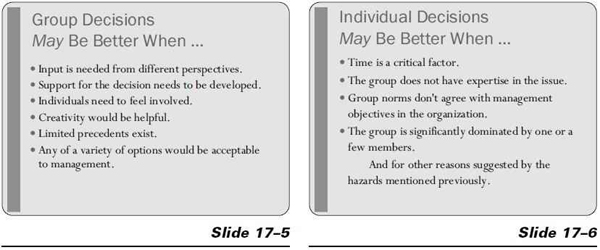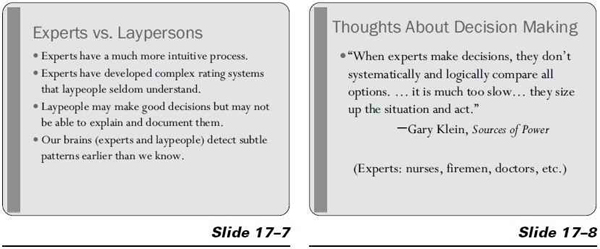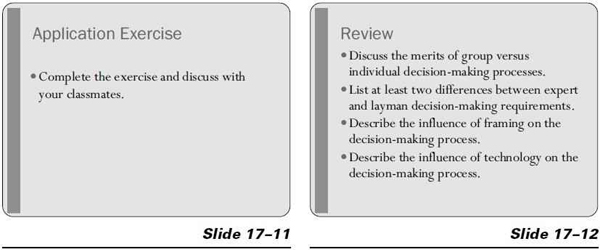C h a p t e r 1 7
Module 9—The Human
Aspect: Emotional and
Irrational Factors
Module 9 covers the human aspects of making decisions. This module is a brief summary of a rich and complex subject.
Training Objectives
After completing this module, the participants should be able to
- discuss the merits of group versus individual decision-making processes
- list at least two differences between expert and layperson decision-making requirements
- describe the influence of framing on the decision-making process
- describe the influence of technology on the decision-making process.
 Module 9 Time
Module 9 Time
- Approximately 1.5 hours
Note: This schedule includes time for a quick review at the start and a learning check at the end.
Materials
- Attendance list
- Pencils, pens, and paper for each participant
- Whiteboard or flipchart, and markers
- Name tags or name tents for each participant
- Worksheet 17–1: Consider Technology Influences and Human Factors
- Computer, screen, and projector for displaying PowerPoint slides; alternatively, overhead projector and overhead transparencies
- PowerPoint slide program (slides 17–1 through 17–13)
- Software and files
- This chapter for reference or detailed trainer’s notes
- Optional: music, coffee, or other refreshments.
Module 9 Preparation
Arrive ahead of time to greet the participants and make sure materials are available and laid out for the way you want to run the class.
Sample Agenda
| 0:00 | Welcome the participants. |
| Have slide 17–1 up on the screen as participants arrive. | |
| Go to slide 17–2 (objectives) as you begin. | |
| Ask for questions and concerns. | |
| 0:05 | PowerPoint presentation with discussion. |
| Begin with slide 17–3 and proceed through slide 17–10. | |
| Discuss as necessary. Some discussion questions are on the slides themselves or on notes to the slides. | |
| 1:05 | Worksheet. |
| Show slide 17–11 as people work. Distribute Worksheet 17–1: Consider Technology Influences and Human Factors. | |
| 1:25 | Wrap-up. |
| Slide 17–12 Review the objectives with the participants. | |
| Ask for questions. | |
| Check for learning (questions can be in oral or written format). | |
| Show slide 17–13 as you dismiss the class. Edit the slide appropriately for your group. |
 Trainer’s Notes
Trainer’s Notes
8:00 a.m. Welcome (5 minutes).
![]() Show slide 17–1 as participants arrive.
Show slide 17–1 as participants arrive.
Take care of housekeeping items.
8:05 a.m. Group Decision Making (35 minutes).
Show slide 17–2 and preview the module objectives.
Show slide 17–3. Tell the participants that predictable things happen as groups make decisions:
- Groups tend to make decisions more slowly than do individuals.
- Groups tend to make decisions that are more extreme (exaggerating conservative or radical tendencies) than those made by the individuals.
- Groups often make weak decisions supported by a minority of the members.
- Groups may have to compromise, making their decisions less effective than desired.
Managers need to be aware of these concerns. For example, if a quick decision is needed, a group decision should be avoided when possible. Nevertheless, group decision making has real advantages.
![]() Have the participants discuss some recent decisions that they have made or been subject to, and ask whether a group or individual made that decision. Get them thinking about the ideas that will be presented in slides 17–5 and 17–6.
Have the participants discuss some recent decisions that they have made or been subject to, and ask whether a group or individual made that decision. Get them thinking about the ideas that will be presented in slides 17–5 and 17–6.
Show slide 17–4.
Read the George Will quote and discuss it briefly with the class before showing the next slide. It should elicit a smile.
Show slide 17–5. Use the bullets as discussion topics.
Some situations where a group decision may be better:
- Input is needed from different perspectives (for example from sales, finance, and production).
- Support for the decision needs to be developed (members of the team can take more detail and credibility back to their constituencies).
- Individuals need to feel involved.
- Creativity would be helpful (a wide range of alternatives is needed).
- Limited precedents exist for the problem or the decision needed.
- A variety of options would be acceptable to management.
Show slide 17–6. Use the bullets as discussion topics.
Group decisions may be undesirable in some situations:
- Time is a critical factor.
- The group does not have expertise in the issue. (It would become a case of the blind leading the blind.)
- The group’s norms don’t agree with management objectives in the organization.
- The group is significantly dominated by one or a few members.
Note that the hazards of group decision making noted earlier on slide 17–3 also are a factor. (Back up and reshow the slide, if it will help make your point.)
Continue the discussion by saying that certain types of decisions are very seldom delegated to a group. Groups don’t do well in matters of resolving conflicts, discipline (except as a jury), counseling, motivational problems, and so on. In most organizations, certain tasks are made the sole responsibility of specific managers, and therefore can’t be delegated to a group. The group may, however, act as an advisory body or sounding board in the decision-making process by the manager.
If you were to take an organizational behavior class, you’d probably spend at least a third of the course time covering the information summarized in the “Group Dynamics” heading, which includes the emotional aspects at play when groups meet to make a decision. This module is a superficial summary of a dense subject, but is included because the emotional aspects of group decision making are relevant to the subject of decision making in organizations.
8:40 a.m. Experts Versus Laypeople (10 minutes).
Show slide 17–7. Module 1 discusses individuals who are experts in their fields and may have developed sufficient background or experience and innate knowledge to make quick and accurate decisions. Thinking too much about a decision, however, can interfere with the ability to solve insight problems. Surprisingly, scientific research shows, for example, that doctors can often make better diagnoses if they know less about the patient.
Ask a food critic about a dish, and—unless you are a food expert yourself— you’ll be amazed by his or her analysis. That doesn’t mean that a layperson’s opinion is “wrong,” only that it may be ungrounded, shallow, or difficult to explain.
Gut feeling is powerful and should be acknowledged. Again, lots of research is coming out in books such as Blink and How We Decide. The scientific research tells us that “gut feelings” should be trusted. The information that has been shared so far in this training program suggests that careful and rational analysis is important in making difficult decisions. Although that is often true, it should not be used to the exclusion of intuition.
Show slide 17–8.
Review the Gary Klein quote with the class and discuss. The point is that experts actually have such a body of knowledge that their intuition is much better than the layperson’s. So where someone who is not an expert in a subject might need lots of research before deciding, an expert would not. Therefore, how much individuals should rely on research and how much they can rely on instinct is mostly determined by their existing background in the subject. That’s certainly not to say that experts can’t be wrong or laypeople can’t have excellent insight and instincts.
8:50 a.m. Framing the Decision (10 minutes).
Show slide 17–9. Tell the class something like this: A person’s perspective can be altered in amazing ways by how the decision issue is stated. Some of the early work on the concept of framing was done by the psychologists Daniel Kahneman and Amos Tversky in 1974.
They found that the way a problem is stated may significantly alter the level of risk that we assign to a situation. In oversimplified terms, this is the “glass half-full” or “glass half-empty” phenomenon. Both terms accurately describe a 50 percent filled beverage container, but the difference in wording shows that different people look at the same problem differently.
Kahneman and Tversky used college students as subjects in various risk-taking exercises. As just one example, they found a substantial difference between groups in the number of students who said they would buy insurance if they were told there was an 80 percent chance that they would not be in an accident than if they were told there was a 20 percent chance that they would be in an accident. Obviously, the risk is the same, but simply stated from either a positive or negative perspective. The group that was given the negative perspective (20 percent chance you will be in an accident) was much more likely to purchase insurance.
As you can imagine, this is a popular study in the marketing field. It deserves some significant attention in decision making and problem solving, as well. Ask the learners why this would be true. What are the implications for a salesperson regarding this research? Discuss with the group.
9:00 a.m. Technology Influences (5 minutes).
Show slide 17–10. We see the influence of changing technology every day. And rapid advances in technology bring us more decisions to make. They also make more information available and give us more tools to help make decisions. Nevertheless, more technology is not always a good thing.
One obvious influence of technology on decision making is the availability of tools such as artificial intelligence, computer software, and so forth. Even if the tools are available, the expertise to use them is also needed.
The faster technology changes, the more decisions will be needed and the more pressure comes with the decisions. So high-technology organizations and their managers and teams will experience higher levels of stress. There will also be more need for research to develop new options (because current procedures are made obsolete by new technology). We feel the need to make decisions quickly, often with great levels of risk.
New technology usually makes more data available and increases the risk of information overload. One may find people dreaming of the good old days when chocolate and vanilla were the only choices. That’s not likely to happen again, as pointed out by Barry Schwartz in his book, The Paradox of Choice. Note: You can find some excellent discussion examples there. See the listing in the “For Further Reading” section at the end of this book.
What this all means is that high-technology organizations must become more familiar with the effective decision-making concepts if they are to maintain their competitiveness. Decision making and problem solving must be streamlined in the process, handled at the most efficient level of the organization, and leveraged with appropriate tools.
 9:05 a.m. Application Exercise (20 minutes).
9:05 a.m. Application Exercise (20 minutes).
Show slide 17–11. Distribute Worksheet 17–1: Consider Technology Influences and Human Factors.  This worksheet continues the pattern of having the participants work on one of the decisions they identified during the module 1 pretest. Individually or in groups, have the participants answer the questions expressed on the worksheet. Move among them to keep them on track and answer any questions.
This worksheet continues the pattern of having the participants work on one of the decisions they identified during the module 1 pretest. Individually or in groups, have the participants answer the questions expressed on the worksheet. Move among them to keep them on track and answer any questions.
Ask participants to complete Worksheet 17–1. If you wish, you may also have participants discuss what technology influences exist in their organizations.
9:25 a.m. Module 9 Summary (5 minutes).
Show slide 17–12 and review the objectives of the modules.
 LEARNING CHECK QUESTIONS
LEARNING CHECK QUESTIONS
You can use the learning check questions and answers in oral or printed form.
Discussion Questions
- What are some of the influences of technology on decision making?
Answers: access to databases, speed with which decisions are needed, frequency of changes in procedures, level in the organization at which decisions are made, and so forth. - List some of the advantages of using group decision making.
Answer: Two heads are better than one; multiple perspectives and more creativity; acceptance of the decision; and so forth. - What types of decisions should not be made by a group?
Answer: Decisions reserved for the manager (because of his or her position within the company), decisions dealing with discipline, decisions that require confidentiality, decisions in which there is no group expertise, and so forth. - What is the concept of framing, and why can you make better decisions if you understand it?
Answer: Framing can be compared to the glass half-full and glass half-empty idea. It’s a matter of how you look at a problem or how it’s put into context. You’ll get better decisions because you are able to see the issue from more than one perspective. Negative framing is more compelling than positive framing.
Multiple Choice Questions
- Which of the following would be a good reason to use a group to make a decision?
a. There’s a crisis going on, and we need a decision NOW! b. The CEO has a strong opinion on the question.
c. A number of cross-functional issues exist. (answer)
d. The decision group has only one person with expertise in the topic. - The term framing, as used in supervisory communications, means to
a. put a matter into a box
b. put it into a context or perspective (answer)
c. create an illusion of responsibility
d. reduce the risk and uncertainty - When using group decision making, the supervisor should
a. reserve the right to modify or reject the group’s decisions
b. set certain limitations on the decision before turning it over to the group
c. have the group assist in generation and evaluation of alternatives but not in the final decision
d. all of the above (answer; there’s room for argument on this—it depends on the nature of the decision and organizational culture.)
9:30 a.m. Thank You for Your Attention.
Show slide 17–13. Edit the slide to include information relevant to participants.
Worksheet 17–1
State the decision you are working with for this training (named by you in the pretest)
What, if any, technological influences affect this decision?
Should this decision be made by a group? Why or why not?
With whom do you need to discuss this decision?
What could affect the timing of this decision? (Deadlines, budgets, cyclical work flows, personalities, and so on)
What other issues facing this decision might be influenced by how the decision is framed?
State the decision in a way someone opposed to your point of view might see it.
© 2010 Decision-Making Training, American Society for Training & Development







